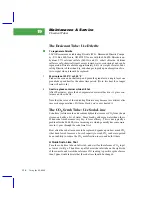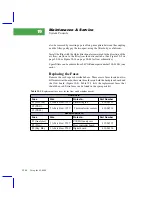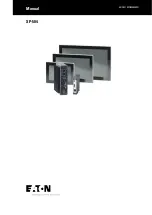
Maintenance & Service
Chemical Tubes
19-4
Using the LI-6400
19
The Desiccant Tube: Use Drierite
■
■
■
■
To regenerate Drierite
LI-COR recommends indicating Drierite (W.A. Hammond Drierite Compa-
ny, P.O. Box 460, Xenia, OH 45385) for use with the LI-6400. Drierite is an-
hydrous 97% calcium sulfate (CaSO
4
) and 3% cobalt chloride. Calcium
sulfate is safe, chemically inert except toward water, economical, and can be
regenerated. Drierite absorbs approximately 6.6% its weight of water. Indi-
cating Drierite is blue when dry, and changes to pink upon absorption of wa-
ter to signal when it should be replaced.
1
90 minutes at 230 ¡C or 450 ¡F
Preheat the oven and a shallow pan. Spread the granules in a single layer one
granule deep and heat for the above time period. (Note: less heat for a longer
time will not work.)
2
Seal in a glass container while still hot
After 90 minutes, place the hot, regenerated material back in itÕs glass con-
tainer and close the lid.
Note that the color of the indicating Drierite may become less distinct after
successive regenerations. If it turns black, youÕve over heated it.
The CO
2
Scrub Tube: Use Soda Lime
Soda lime (calcium oxide and sodium hydroxide) removes CO
2
from the air
stream, and adds a bit of water. Some brands add more water than others.
When soda lime becomes very dry, it loses efficacy. This is not typically a
problem for the LI-6400, since incoming air, which generally has some mois-
ture in it, goes through the soda lime first.
How often the soda lime needs to be replaced depends upon how much CO
2
it has been forced to remove. Loss of capacity to scrub CO
2
can be recognized
by an inability to reduce the CO
2
mole fraction to zero and hold it there.
A Quick Soda Lime Test
Turn the soda lime tube on full scrub, and wait for the reference CO
2
to get
as low as it will go. Then blow a puff of air at the inlet tube on the right side
of the console, and watch the reference CO
2
reading. A positive spike of more
than 2 ppm would indicate that the soda lime should be changed.
Summary of Contents for LI-6400
Page 1: ...Using the LI 6400 Portable Photosynthesis System ...
Page 15: ...Part I The Basics ...
Page 16: ......
Page 174: ...Making Measurements Answers to Questions 4 56 Using the LI 6400 4 ...
Page 175: ...Part II Useful Details ...
Page 176: ......
Page 200: ...Standard Tools Power ON Hooks 5 24 Using the LI 6400 5 ...
Page 214: ...Real Time Data Real Time Graphics 6 14 Using the LI 6400 6 ...
Page 234: ...Environmental Control Light Control 7 20 Using the LI 6400 7 ...
Page 244: ...Light Sensor Considerations Gallium Arsenide Phosphide GaAsP Sensor 8 10 Using the LI 6400 8 ...
Page 288: ...Data Logging Making Your Own AutoPrograms 9 44 Using the LI 6400 9 ...
Page 289: ...Part III Working With Files ...
Page 290: ......
Page 312: ...The LPL File System Troubleshooting 10 22 Using the LI 6400 10 ...
Page 340: ...Downloading Files Using a Data Capture Program 11 28 Using the LI 6400 11 ...
Page 375: ...Part IV Configuration Issues ...
Page 376: ......
Page 420: ...Defining User Variables Old Style vs New Style 15 18 Using the LI 6400 15 ...
Page 454: ...Using an Energy Balance Further Reading 17 12 Using the LI 6400 17 ...
Page 455: ...Part V Maintenance Troubleshooting ...
Page 456: ......
Page 572: ...Troubleshooting Useful Information 20 46 Using the LI 6400 20 ...
Page 593: ...Part VI Programming ...
Page 594: ......
Page 622: ...Programming with LPL Compiler Directives 22 28 Using the LI 6400 22 ...
Page 846: ...Index I 16 Using the LI 6400 ...
















































